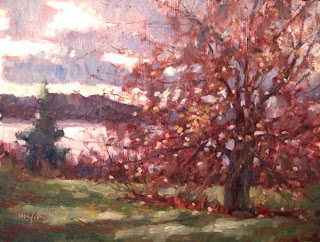As of this evening, Trina and I have made it safely to Show Low, Arizona, on our way to Sedona. On the way here, we stopped in Texas to visit with my mentor, Ann Templeton, who recently moved from New Mexico to a small town near Austin. If you don't know Ann, she's a wonderful teacher who's been at it for over 30 years. I wrote her first book, a retrospective entitled The Art of Ann Templeton: A Step Beyond. Her latest book, which is an instructional book, is called Color and Beyond and came out this year. I didn't write it, but I do recommend it as a great companion volume. She's also teaching a mentoring workshop next August for me in Maine. (See www.anntempleton2009.com for more.)

Ann Templeton
While visiting Ann, she called up some old friends who came to visit. Bobbie Kilpatrick co-ran an art school with Ann for many years. Vicki McMurry , whom I met at my first Sedona Plein Air Festival, authored Mastering Color: The Essentials of Color for North Light Books. Betty Rhoades once owned two art galleries in Dallas. Each of these is an excellent painter, and at the end, I'll show some of their art.

Bobbie Kilpatrick
p_2.jpg)
Vicki McMurry

Betty Rhoades








 For my Sarasota workshop, I had a full day before the workshop to explore, and I'm glad I did. I was able to take students to some rich painting spots: Myakka River State Park, Selby Gardens and Lido Key.
For my Sarasota workshop, I had a full day before the workshop to explore, and I'm glad I did. I was able to take students to some rich painting spots: Myakka River State Park, Selby Gardens and Lido Key.




































